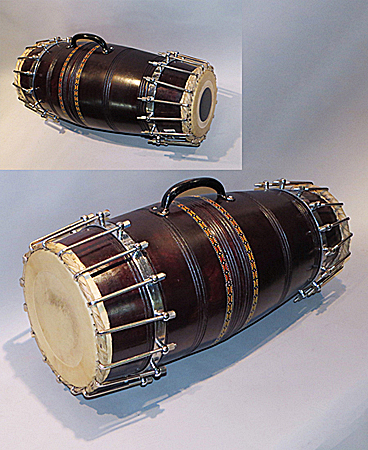
Owner: HWMC
Catalog#: 2AS-MBST-04-16
Struck Membranophones
India ‘Pakhavaj’
India
Northern Indian
Wood, goat skin, metal, paste, cloth fiber Mid 20th century
Length: 26 in, Large diameter: 10 in, Small diameter: 8 in
Membranophones – Struck Membranophones
The pakhavaj (paksa + vadya = “side + instrument”) is the most common north Indian representative of the class of double headed barrel shaped drums known as mridang. It is well-known for accompanying in the old northern Indian dhrupad and dhammar style, and some musicologists believe that it is the predecessor of the tabla. The pakhavaj is similar to the mridangam of southern India.
This modern pakhavaj is often played for Orissi dancers and occasionally for kathak. It is also found in the classical form music from Rajasthan known as haveli sangeet. It consists of a two-headed (tenor and bass) wooden shell drum with nut and bolt tension. It is held horizontally and is played with the hands. The right head (called: dayan) is identical to the tabla except somewhat larger. The left head is similar to the tabla bayan (called: bayan), and has a black permanent spot in the center. Pakhavaj compositions are passed down from generation to generation. Like the tabla, they are taught by a series of mnemonic syllables known as bol, however, tabla bols and the pakhavaj bols are not the same.
